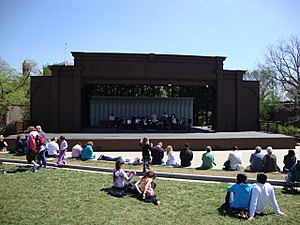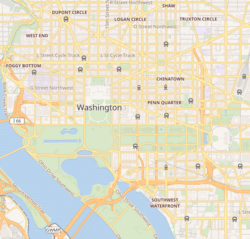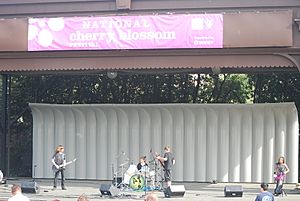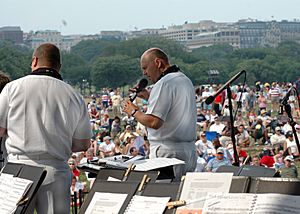National Sylvan Theater facts for kids

MIT Concert Band performs at the National Sylvan Theater in 2011
|
|
| Address | Washington Monument, National Mall Washington, D.C. United States |
|---|---|
| Coordinates | 38°53′18″N 77°02′04″W / 38.888333°N 77.034444°W |
| Opened | April 4, 1917 |
The National Sylvan Theater, often called the Sylvan Theater, is an outdoor stage. It is located on the grounds of the Washington Monument in Washington, D.C., USA. The theater is found near the corner of 15th Street and Independence Avenue. It is about 450 feet (137 meters) southeast of the Washington Monument. The stage is made of wood and sits in a low area. Trees surround it, making it look like a natural outdoor theater. Up to 10,000 people can gather here for events. The Sylvan Theater was the first theater in the United States funded by the government.
Contents
History of the Sylvan Theater
The idea for the Sylvan Theater came from Alice Pike Barney (1857–1931). She worked to make Washington, D.C., a major cultural center in the early 1900s. Alice Pike Barney was known for creating amazing ballets, mimes, and plays. During World War I, she convinced the U.S. Congress to approve and pay for the theater. This happened in 1916. She also wrote the first few plays performed there.
Building the First Federal Theater
The theater was designed to hold over 8,000 people. The United States Department of War built and took care of it. This department managed the parks in Washington, D.C., at the time. Any performances needed approval from the Office of Public Buildings and Grounds. The government paid for the stage, lights, and security. Other costs were covered by the groups putting on the shows. Colonel W. H. Harts, the Superintendent of Parks, was its first director.
Opening Day and Early Events
The Sylvan Theater opened on April 4, 1917. President Woodrow Wilson and his Cabinet were there. It became the nation's first outdoor theater supported by the federal government. About 2,800 people attended the first show. The seats were set up so everyone had a clear view. The show included a play called The Drama Triumphant.
Many years later, on July 4, 1993, about 150,000 people came to two concerts. These "American Roots Fourth of July" concerts featured traditional American music. The National Park Service helped put on these popular events.
Future Plans for the Theater
In 2010, a plan was made to replace the Sylvan Theater. The idea was to build a new, modern facility. This new space would offer food, restrooms, and better seating. It was planned to be in a wooded area below street level. This new design would offer great views of the Washington Monument.
Design and Construction Details
The National Sylvan Theater was built in early 1917. It is located southeast of the Washington Monument. The stage is about 5 feet (1.5 meters) above the ground. It is 80 feet (24 meters) wide and 30 feet (9 meters) deep. There are also two side sections, each 30 square feet (2.8 square meters). The dirt used to build the stage was brought in for free.
Stage Features and Lighting
The stage has three sets of stone steps. These steps allow performers to get to the stage from the back. Special electric cables were installed for large projector lamps. These lamps provided light for the shows. Instead of a regular curtain, steam jets could be used. The steam would rise along the front of the stage. This hid the performers and added a magical effect.
Landscaping and Surroundings
The sides of the stage were covered with many plants. Forsythia and other shrubs were moved from the Tidal Basin to the theater area. The entire stage area was covered with soil and grass. This made sure the ground was ready for the opening performance on June 2, 1917.
The construction involved moving a lot of clay and planting many shrubs and trees. They also laid sewer pipes and built flagstone steps. All these elements helped create the beautiful outdoor theater.
Events and Gatherings
Today, the Sylvan Theater is a popular place for many free events. These include military concerts, musicals, Shakespeare plays, puppet shows, and ballet. These shows happen in the spring, summer, and fall.
Concerts and Performances
Since at least 2010, the Military Band Summer Concert Series has been held here. From June to August, concerts take place on Tuesday, Thursday, Friday, and Sunday nights. Bands from the four U.S. military branches perform. They play military marches, patriotic songs, and some classical music.
Every August, Tchaikovsky's 1812 Overture is performed. This special show includes real cannons fired by the 3rd U.S. Infantry. This is one of the United States Army Band's most popular events.
Rallies and Important Moments
The Sylvan Theater is also used for government events and ceremonies. Many rallies and protests have taken place here. It is often a starting or ending point for organized marches. For example, in 2002, protesters gathered to "Stop the War at Home and Abroad."
In 1944, 10,000 women from the WAVES (Women Accepted for Volunteer Emergency Service) marched here. They gathered at the theater before sitting on the grass. In 1959, Martin Luther King Jr. spoke to 26,000 people at the theater. This was for the Youth March for Integrated Schools. During the 1963 Great March on Washington, the march moved from the Sylvan Theater. Singers like Joan Baez and Judy Collins sang We Shall Overcome as people marched.
The theater has also hosted religious services. In the 1950s, an outdoor Mass was held with a sermon by Archbishop Fulton J. Sheen.




